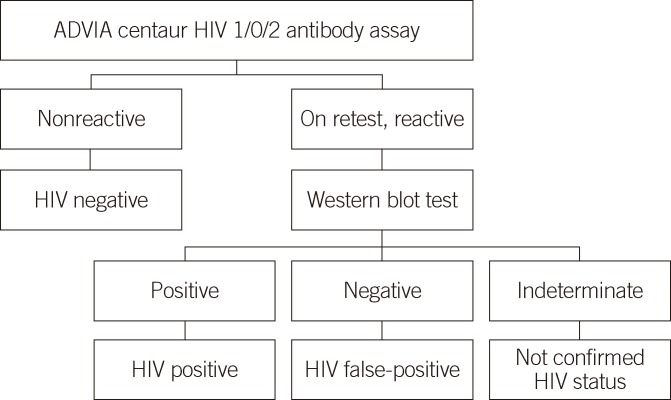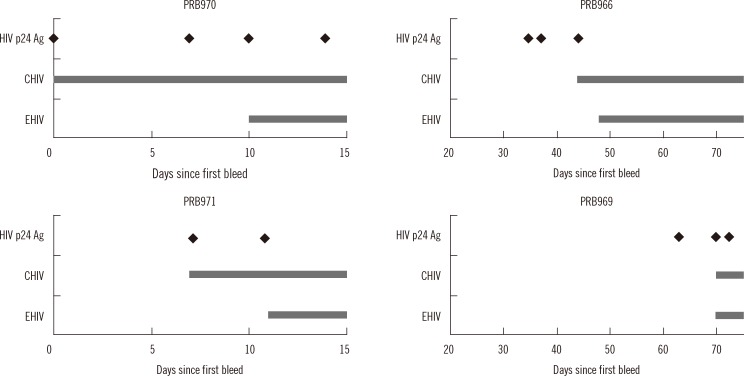Ann Lab Med.
2013 Nov;33(6):420-425. 10.3343/alm.2013.33.6.420.
Reduction of the HIV Seroconversion Window Period and False Positive Rate by Using ADVIA Centaur HIV Antigen/Antibody Combo Assay
- Affiliations
-
- 1Department of Laboratory Medicine and Genetics, Samsung Medical Center, Sungkyunkwan University School of Medicine, Seoul, Korea. eskang@skku.edu
- KMID: 1711315
- DOI: http://doi.org/10.3343/alm.2013.33.6.420
Abstract
- BACKGROUND
Early diagnosis of HIV infection reduces morbidity and mortality. Fourth-generation HIV detection assays are more sensitive because they can detect p24 antigen as well as anti-HIV antibodies. In this study, we evaluated the performance of a new fourth-generation ADVIA Centaur HIV antigen/antibody combo (CHIV) assay (Siemens Healthcare Diagnostics Inc., USA) for early detection of HIV infection and reduction of false positive rate.
METHODS
Four seroconversion panels were included. The third-generation ADVIA Centaur HIV 1/O/2 enhanced (EHIV) assay (Siemens Healthcare Diagnostics Inc., USA) and fourth-generation CHIV assay were used to test each panel for HIV infection. The presence of antigen was confirmed using HIV p24 antigen assay. To evaluate false-positivity and specificity, 54 HIV false-positive and HIV-negative serum samples from 100 hospitalized patients and 600 healthy subjects were included.
RESULTS
Compared to the EHIV assay, the CHIV assay had a shorter window for three of the seroconversion panels: a difference of 10 days and two bleeds in one panel, and 4 days and one bleed in the other two panels. Only 34 of the 54 (63%) samples known to yield false-positive results by EHIV assay had repeatedly yielded reactive results in the CHIV assay. One of the 600 healthy subjects had a false-positive result with the CHIV assay; thus, the specificity was 99.85% (699/700). CHIV accurately determined the reactive results for the HIV-confirmed serum samples from known HIV patients and Korea Food & Drug Administration (KFDA) panels.
CONCLUSIONS
The new fourth-generation ADVIA Centaur HIV assay is a sensitive and specific assay that shortens the serological window period and allows early diagnosis of HIV infection.
Keyword
MeSH Terms
Figure
Reference
-
1. UNAIDS. AIDS epidemic update 2009. Geneva: UNAIDS/WHO;2009.2. Korea Centers for Disease Control and Prevention. Analysis of HIV/AIDS Notifications in Korea. Updated on Jul 2013. http://www.cdc.go.kr/CDC/notice/CdcKrTogether0302.jsp?menuIds=HOME001-MNU0004-MNU0085-MNU0088&cid=21276.3. Lee SH, Kim KH, Lee SG, Chen DH, Jung DS, Moon CS, et al. Trends of mortality and cause of death among HIV-infected patients in Korea, 1990-2011. J Korean Med Sci. 2013; 28:67–73. PMID: 23341714.
Article4. Choe PG, Park WB, Song JS, Kim NH, Park JY, Song KH, et al. Late presentation of HIV disease and its associated factors among newly diagnosed patients before and after abolition of a government policy of mass mandatory screening. J Infect. 2011; 63:60–65. PMID: 21621848.
Article5. Branson BM, Handsfield HH, Lampe MA, Janssen RS, Taylor AW, Lyss SB, et al. Revised recommendations for HIV testing of adults, adolescents, and pregnant women in health-care settings. MMWR Recomm Rep. 2006; 55:1–17. quiz CE1-4. PMID: 16988643.6. Mahajan VS, Pace CA, Jarolim P. Interpretation of HIV serologic testing results. Clin Chem. 2010; 56:1523–1526. PMID: 20876778.
Article7. Gürtler L, Mühlbacher A, Michl U, Hofmann H, Paggi GG, Bossi V, et al. Reduction of the diagnostic window with a new combined p24 antigen and human immunodeficiency virus antibody screening assay. J Virol Methods. 1998; 75:27–38. PMID: 9820572.
Article8. Busch MP, Satten GA. Time course of viremia and antibody seroconversion following human immunodeficiency virus exposure. Am J Med. 1997; 102:117–124. discussion 125-6. PMID: 9845513.
Article9. Weber B, Fall EH, Berger A, Doerr HW. Reduction of diagnostic window by new fourth-generation human immunodeficiency virus screening assays. J Clin Microbiol. 1998; 36:2235–2239. PMID: 9665998.
Article10. Brust S, Duttmann H, Feldner J, Gürtler L, Thorstensson R, Simon F. Shortening of the diagnostic window with a new combined HIV p24 antigen and anti-HIV-1/2/O screening test. J Virol Methods. 2000; 90:153–165. PMID: 11064116.
Article11. Weber B, Gürtler L, Thorstensson R, Michl U, Mühlbacher A, Bürgisser P, et al. Multicenter evaluation of a new automated fourth-generation human immunodeficiency virus screening assay with a sensitive antigen detection module and high specificity. J Clin Microbiol. 2002; 40:1938–1946. PMID: 12037046.
Article12. Beelaert G, Fransen K. Evaluation of a rapid and simple fourth-generation HIV screening assay for qualitative detection of HIV p24 antigen and/or antibodies to HIV-1 and HIV-2. J Virol Methods. 2010; 168:218–222. PMID: 20561542.
Article13. Weber B, Orazi B, Raineri A, Thorstensson R, Bürgisser P, Mühlbacher A, et al. Multicenter evaluation of a new 4th generation HIV screening assay Elecsys HIV combi. Clin Lab. 2006; 52:463–473. PMID: 17078473.14. Kang HJ, Yoo KH, Kim HS, Cho HC. Evaluation of Abbott fourth generation HIV antigen and Antibody assays. Korean J Lab Med. 2006; 26:39–44. PMID: 18156698.
Article15. Kwon JA, Yoon SY, Lee CK, Lim CS, Lee KN, Sung HJ, et al. Performance evaluation of three automated human immunodeficiency virus antigen-antibody combination immunoassays. J Virol Methods. 2006; 133:20–26. PMID: 16313975.
Article16. Butto S, Suligoi B, Fanales-Belasio E, Raimondo M. Laboratory diagnostics for HIV infection. Ann Ist Super Sanita. 2010; 46:24–33. PMID: 20348616.
Article17. Song EY, Hur M, Roh EY, Park MH, Moon HW, Yun YM. Performances of four fourth-generation human immunodeficiency virus-1 screening assays. J Med Virol. 2012; 84:1884–1888. PMID: 23080491.
Article18. Pumarola T, Freeman J, Saxton E, Dillon P, Bal T, van Helden J. Performance evaluation of the ADVIA Centaur(®) HIV Ag/Ab Combo assay. J Virol Methods. 2010; 170:16–20. PMID: 20723562.
Article19. Erickson CP, McNiff T, Klausner JD. Influenza vaccination and false positive HIV results. N Engl J Med. 2006; 354:1422–1423. PMID: 16571889.
Article20. Chao TT, Sheffield JS, Wendel GD Jr, Ansari MQ, McIntire DD, Roberts SW. Risk factors associated with false positive HIV test results in a low-risk urban obstetric population. J Pregnancy. 2012; 2012:841979. PMID: 21860798.
Article21. Kasper DL, editor. Harrison's principles of internal medicine. 18th ed. New York: McGraw-Hill;2012.
- Full Text Links
- Actions
-
Cited
- CITED
-
- Close
- Share
- Similar articles
-
- Evaluation of Abbott Fourth Generation HIV Antigen and Antibody Assays
- Performance Evaluation of Access HIV Combo V2 Assay
- HIV-1 p24 Antigen Detection by Immune Complex Dissociation and Neutralization in HIV-1 Infected Persons in Korea
- Performance of the Elecsys HIV combi PT Assay Compared to the ARCHITECT HIV Ag/Ab Combo Assay
- Evaluation of Vironostika HIV Uni-Form II Ag/Ab Enzyme Immunoassay Kit for Simultaneous Detection of Antigen and Antibody of HIV



